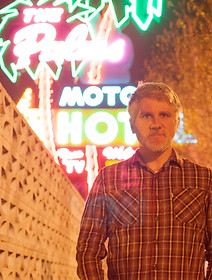BIOGRAPHY
Chronicling a fascination with 1950’s and 60’s iconography, Robert Mars creates artwork from his studio in Connecticut that celebrates the commonplace objects and icons of an America long past in a thoroughly modern, and exquisitely
constructed, manner. His eye for a distinct facet of American history is impeccable, and his ability to manipulate both the color and wordplay of vintage printed material has earned him reference with the likes of Andy Warhol, Robert Rauschenberg, and Richard Diebenkorn, among other masters from the School of Pop. By taking inspiration from the Golden Age of American popular culture and celebrating figures of the 1950’s and 60’s, Mars’ artwork chronicles an evolving relationship with celebrity. Through the application of a rich color palette and tongue in cheek attitude, Mars’ paintings evoke a vintage quality of design and pay homage to the idealized age of growth and hopefulness that was prevalent in the USA at the end of World War II. A time before the internet and mobile technology, where visual information was not constantly blasted to millions, and there was no such thing as instant digital celebrities, where instead people lived with the myth of the unique, untouchable and unforgettable personalities of Marilyn Monroe, Elizabeth Taylor, James Dean, Audrey Hepburn, Elvis Presley, and many others.
By merging his own concept of personal idols with those of mainstream culture, Mars is able to focus his work on a deeper analysis of the Golden Age of Americana. His early work focuses on many of the architectural and mechanical forms of the 50’s and 60’s, where muscle cars, motels, kitschy logos, and hulking monuments to the "modern" feeling of the time reigned supreme. More recently, however, Mars’ artwork has shifted toward the culture of celebrity, and he is strikingly attuned to the fact that these instantly recognizable and larger than life personalities continue to resonate not only with contemporary American culture, but with a worldwide market.
In 2014, after serious reflection upon his artistic thought, his process, wanting to explore traditionalism from another angle, and through influence from his wife, Mars began to delve deeper into American culture by focusing on Folk Art and Contemporary American Quiltmakers. By combining vintage wallpapers with quilt patterns Mars was able to further differentiate himself from the scores of artists using similar iconic themes. Mars is credited as being the first to incorporate quilt patterns and a folk art sensibility into a pop art aesthetic creating his own genre of folk laced pop.
A graduate of Parsons School of Design in New York, Mars often references his decades as a graphic designer in his work. He begins the creative process by preparing his surface with multiple layers of vintage magazine paper in order to define the edges and delineate the background planes of color. He then alternates layers of paint and vintage paper ephemera, sanding away portions of the layers as he
works, revealing the desired portions of under painting with the overall intention to provide the viewer with a muted window into America’s past. Robert Mars’ artwork is exhibited worldwide including museum collections in Munich, Tokyo, Amsterdam, London, Boston, New York, Los Angeles, Laguna Beach, Paris, Aspen and Naples. His artwork was selected for the Absolut Vodka Blank campaign alongside Damien Hirst, and his largest sized piece to date was acquired by Philip Morris/Altria for their corporate headquarters in Virginia. In 2015 Mars was chosen for the cover of Neiman Marcus’ May Book, CocaCola purchased several existing works and ordered commissions for a world tour celebrating the 100 year anniversary of their trademark bottle shape, in which his artwork was spotlighted. In 2016 Mars had a solo exhibition at the Evansville Museum of Art in Indiana, where he was an artist in residence and guest lecturer, followed by group exhibitions at the Coca-Cola Museum titled “Effervescence” and the Cornell Museum titled “Fifteen minutes”. In late 2017 he had his first published monograph through Scala publishing and DTR Modern Galleries. 2018 will end with several gallery exhibitions and a spotlight at Art Basel in Miami.

